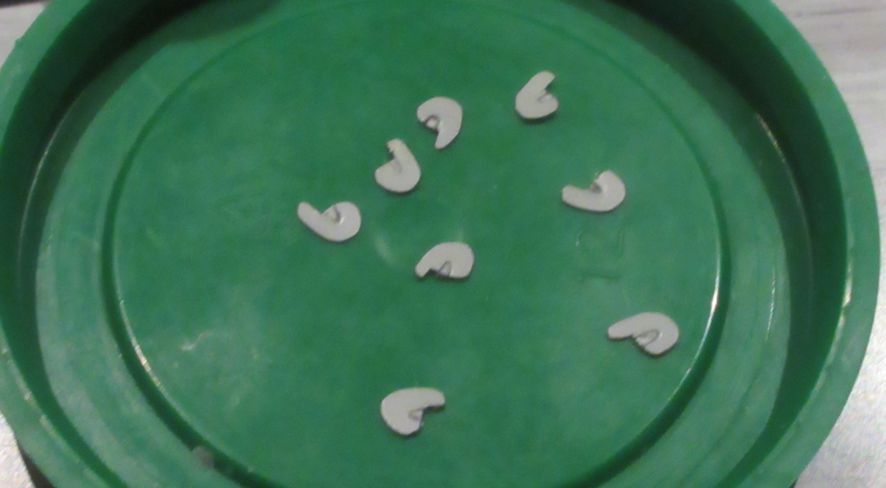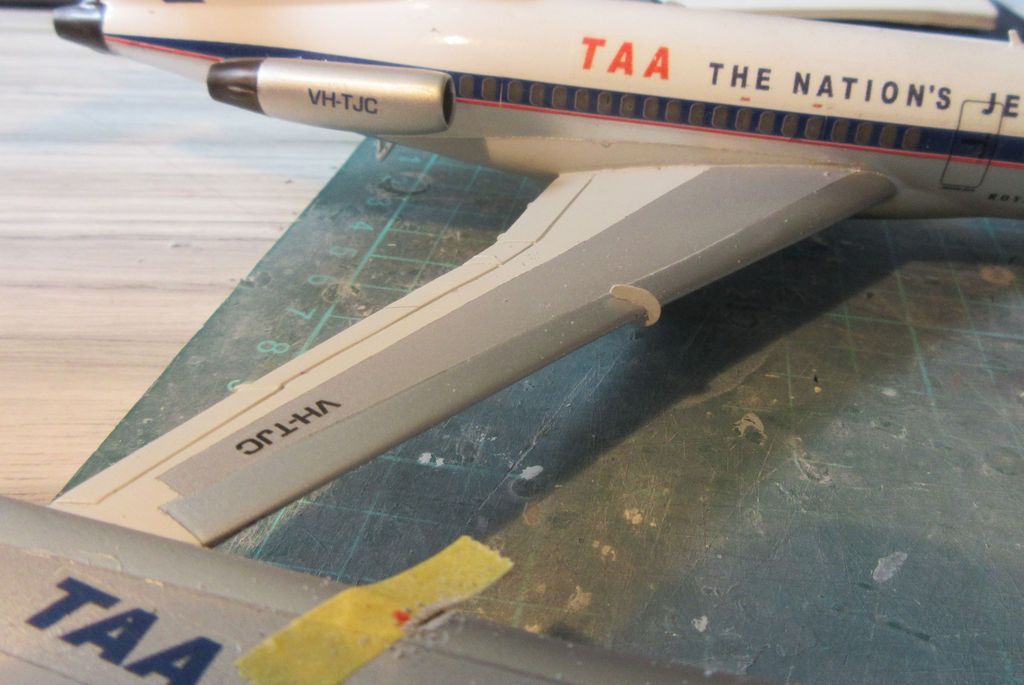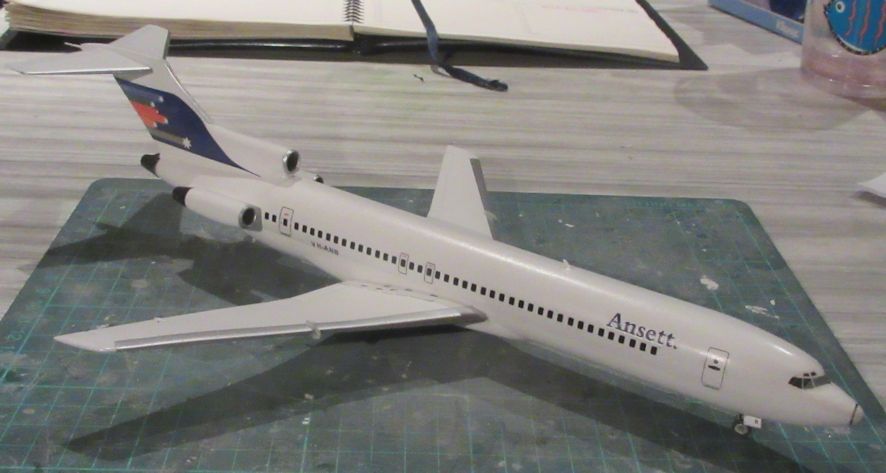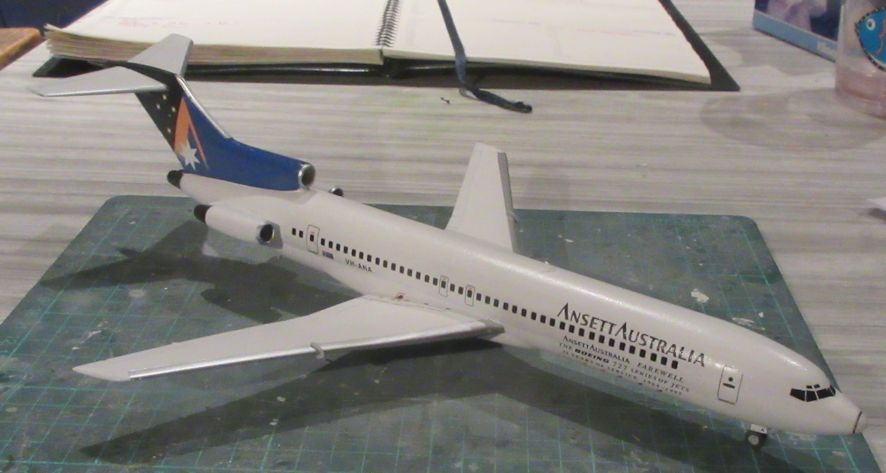My Boeing 727 project
Re: My Boeing 727 project
I like the idea mate. I'm gonna blatantly steal this for sure 
Head A/CAM Phantom Phanatic, Shit Stirrer and Karma Bus Driver toot fkn toot 
- hrtpaul
- Posts: 4165
- Joined: Sat Apr 12, 2014 10:44 am
- Location: Like I'm gonna tell you lot
Re: My Boeing 727 project
So, here we are with some 727 wing fences. They didn't turn out too bad but they are not identical, which is always a problem with my modelling. Still, if I make enough of them I can pick the best ones to use.

Why, I hear you ask, haven't I tried them on the wings they are destined for. A sad story that. When I pulled off the masking tape on the two 727s what were ready some of the white paint came off too, Not too much, but enough that I've had to sand back and respray the entire airframes again. Fortunately this is not a lengthy tedious process using automotive lacquers and Tamiya rattle cans. Here they sit in my room for a day or two to let the paint cure properly..

More progress soon, but not as soon as I had hoped.
Leigh

Why, I hear you ask, haven't I tried them on the wings they are destined for. A sad story that. When I pulled off the masking tape on the two 727s what were ready some of the white paint came off too, Not too much, but enough that I've had to sand back and respray the entire airframes again. Fortunately this is not a lengthy tedious process using automotive lacquers and Tamiya rattle cans. Here they sit in my room for a day or two to let the paint cure properly..

More progress soon, but not as soon as I had hoped.
Leigh
- F-27pax
- Posts: 973
- Joined: Fri Apr 18, 2014 11:40 pm
Re: My Boeing 727 project
PS. I have a technical question for anyone who has stood close to the undercarriage of a 727. What colour were the wheel hubs?
Leigh
Leigh
- F-27pax
- Posts: 973
- Joined: Fri Apr 18, 2014 11:40 pm
Re: My Boeing 727 project
While I'm waiting for the white paint on the 727-200s I'm working on to set fully I thought I should go back and put wing fences on the 727-100s I've already finished. It turns our that even though the fences are not identical in shape they are far enough on the model that this is not obvious. Here's what the updated model with fences looks like.

The tape on the other wing is what I used to mark where the fence needs to go and how far back the cut needs to go.
Leigh

The tape on the other wing is what I used to mark where the fence needs to go and how far back the cut needs to go.
Leigh
- F-27pax
- Posts: 973
- Joined: Fri Apr 18, 2014 11:40 pm
Re: My Boeing 727 project
Great work and a nice solution to the problem. Well done mate 
Head A/CAM Phantom Phanatic, Shit Stirrer and Karma Bus Driver toot fkn toot 
- hrtpaul
- Posts: 4165
- Joined: Sat Apr 12, 2014 10:44 am
- Location: Like I'm gonna tell you lot
Re: My Boeing 727 project
The wheel hubs were Boeing Gray as I remember them Leigh, on both Ansett and TAA. Not that you could see it much due to brake dust covering the entire wheel .!!
- Knotty
- Posts: 580
- Joined: Sat Apr 12, 2014 6:39 am
Re: My Boeing 727 project
Thanks knotty. That explains why I couldn't figure it out after peering at an endless number of 727 pictures.
Later than expected, but done nevertheless, are a couple more 727s. Having had a few distractions this past month or so I decided to do a couple of simpler one, and you can't get much simpler than all over white, which means Ansett more or less. There's nothing remarkable or difficult about these models apart from the seams and wing/fuselage joints which need a bit of attention. Even the current boxing of this kit takes a bit of work to smooth out all the edges. One thing that caused a little consternation this time is the fit between the engine pylons and the fuselage. On the Airfix 727-100 kit the fit is excellent and needs no further work than a dob of glue. With the new fuselages for the 727-200 version of the kit the fit is really quite poor. This took me by surprise and needed a lot of filling and sanding at the last minute to resolve this problem. Just as well I discovered this before making a version in which the fuselage and pylons are different colours. The decals are by Hawkeye.
First is an Ansett. 727-200 from the early 1980s, VH-ANB. The windows could present your average modeller with a problem if they aren't in the habit of counting windows. On the port side there is one window too many and on the starboard side four or five (I didn't make a note at the time).

Next is an Ansett Australia 727-200 in the final livery, including the logos celebrating the long service that 727s gave in Australia. On this one the windows are accurate so no problems. On the other hand, I had trouble with the tail decals which are big, delicate and a challenge to handle. Take care with them. If they don't fit and there are white gaps showing after everything has settled down you will be in the same boat as me. I found that the best matches of paint to cover these white gaps that I had in my collection of paints were Modelmaster deep sea blue and Modelmaster Blue Angels blue.

Leigh
Later than expected, but done nevertheless, are a couple more 727s. Having had a few distractions this past month or so I decided to do a couple of simpler one, and you can't get much simpler than all over white, which means Ansett more or less. There's nothing remarkable or difficult about these models apart from the seams and wing/fuselage joints which need a bit of attention. Even the current boxing of this kit takes a bit of work to smooth out all the edges. One thing that caused a little consternation this time is the fit between the engine pylons and the fuselage. On the Airfix 727-100 kit the fit is excellent and needs no further work than a dob of glue. With the new fuselages for the 727-200 version of the kit the fit is really quite poor. This took me by surprise and needed a lot of filling and sanding at the last minute to resolve this problem. Just as well I discovered this before making a version in which the fuselage and pylons are different colours. The decals are by Hawkeye.
First is an Ansett. 727-200 from the early 1980s, VH-ANB. The windows could present your average modeller with a problem if they aren't in the habit of counting windows. On the port side there is one window too many and on the starboard side four or five (I didn't make a note at the time).

Next is an Ansett Australia 727-200 in the final livery, including the logos celebrating the long service that 727s gave in Australia. On this one the windows are accurate so no problems. On the other hand, I had trouble with the tail decals which are big, delicate and a challenge to handle. Take care with them. If they don't fit and there are white gaps showing after everything has settled down you will be in the same boat as me. I found that the best matches of paint to cover these white gaps that I had in my collection of paints were Modelmaster deep sea blue and Modelmaster Blue Angels blue.

Leigh
- F-27pax
- Posts: 973
- Joined: Fri Apr 18, 2014 11:40 pm
Re: My Boeing 727 project
Very nice there mate 
Head A/CAM Phantom Phanatic, Shit Stirrer and Karma Bus Driver toot fkn toot 
- hrtpaul
- Posts: 4165
- Joined: Sat Apr 12, 2014 10:44 am
- Location: Like I'm gonna tell you lot
Return to Member's Works in Progress
Who is online
Users browsing this forum: No registered users and 717 guests
